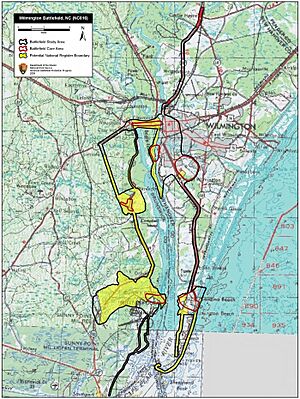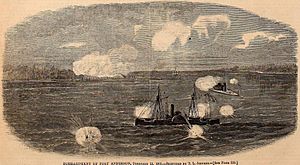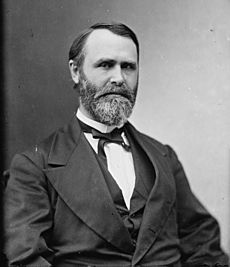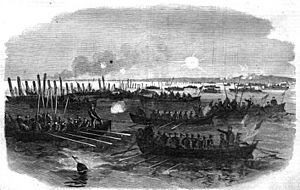Battle of Wilmington facts for kids
Quick facts for kids Battle of Wilmington |
|||||||
|---|---|---|---|---|---|---|---|
| Part of the American Civil War | |||||||
 Region down Cape Fear River |
|||||||
|
|||||||
| Belligerents | |||||||
| Commanders and leaders | |||||||
| John M. Schofield David D. Porter |
Braxton Bragg | ||||||
| Units involved | |||||||
| Department of North Carolina Army of the Ohio North Atlantic Blockading Squadron |
Confederate Department of North Carolina | ||||||
| Strength | |||||||
| 12,000 | 6,000 | ||||||
| Casualties and losses | |||||||
| 305 | 845 | ||||||
The Battle of Wilmington was a series of fights during the American Civil War in February 1865. It took place mostly around Wilmington, North Carolina. The Union had just won the Second Battle of Fort Fisher in January. This meant Wilmington, a city 30 miles up the river, could no longer be used by the Confederacy as a vital port. Union troops captured Wilmington after breaking through Confederate defenses along the Cape Fear River. Before leaving, Confederate General Braxton Bragg burned many supplies like tobacco and cotton. He did this so the Union army couldn't use them.
Contents
Why Wilmington Was Important
After Fort Fisher was captured, the port city of Wilmington was completely blocked. This meant Confederate ships called blockade runners could no longer bring supplies into the city. These ships were important for getting goods past the Union's naval blockade. Wilmington was the last major port the Confederacy had on the Atlantic coast.
Confederate forces left other defenses near the mouth of the Cape Fear River. They had to leave behind their heavy cannons because they couldn't move them upriver. Even though losing Fort Fisher had lowered spirits, many soldiers still felt determined.
General Braxton Bragg was in charge of defending Wilmington. His forces included General Robert Hoke's division and some artillery and local home guard troops. Hoke's soldiers were on both sides of the Cape Fear River. Bragg stayed in Wilmington to move out valuable government supplies. He also wanted to stop Union forces from helping General William T. Sherman's army.
Union General Ulysses S. Grant wanted to use Wilmington as a base. From there, Union armies could advance to Goldsboro, North Carolina. Rail lines from Wilmington to Goldsboro would help resupply Sherman's armies. Sherman was moving north through the Carolinas at this time. In February 1865, the Union XXIII Corps arrived to help. Major General John Schofield took command of the combined Union forces. He began moving against Wilmington in mid-February.
The Battle Begins
The Battle of Wilmington involved three main fights along the Cape Fear River.
Fighting at Sugar Loaf Line
Confederate General Robert Hoke's division was positioned at the Sugar Loaf Line. This was north of Fort Fisher. On February 11, General Schofield attacked Hoke's line. The fight started with Union gunboats firing at the Confederate defenses from the ocean side.
About 30 minutes later, Union troops began to advance. However, their left side was slowed down by a swamp near the river. By late afternoon, the Union forces had pushed back the Confederate skirmish line. But Schofield realized the main Confederate defenses were too strong for a direct attack. He decided to try to capture Wilmington from the west side of the river instead.
Attack on Fort Anderson
Major General Jacob Dolson Cox's division was moved to the west bank of the Cape Fear River. Their mission was to attack Fort Anderson. This was the main fort protecting Wilmington from the west.
Rear Admiral David Dixon Porter's gunboats sailed up the river. They shelled Fort Anderson, silencing all twelve of its guns. A Union officer, Lt. Commander William B. Cushing, used a clever trick. He built a fake monitor ship, sometimes called a Quaker gun. The goal was to trick the Confederates into setting off their water mines. This would clear a path for Porter's real gunboats. The trick worked, and both Cushing and Porter were very happy.
Meanwhile, General Cox's troops moved towards Fort Anderson on the west bank. Cox sent some brigades to attack the fort directly. Other brigades marched through the swamps to get around the Confederate side. These troops met Confederate cavalry and pushed them back.
The fort's commander, General Johnson Hagood, realized he was about to be trapped. He got permission to pull back to a new defensive line along Town Creek. Just as Hagood's troops started to leave, Union forces attacked. They captured the fort easily and took some prisoners.
The Battle at Town Creek
General Cox chased Hagood from Fort Anderson. On February 19, he caught up to the Confederate forces at the Town Creek Line. General Hoke's division had moved to a position three miles south of Wilmington. This was across the river from Hagood's troops.
Hagood had burned the only bridge across Town Creek to slow Cox down. He then dug in on the north side of the river. Cox was eager to try his plan to surround the enemy. The creek was too deep to cross easily. On February 20, Cox's troops found a single flat-bottom boat. They used it to ferry three brigades across the creek. A fourth brigade fought Hagood's forces as a distraction.
Hagood soon discovered the Union's flanking movement. He realized his position was no longer safe and decided to retreat back to Wilmington. He left two regiments behind to cover his escape. The Union soldiers then waded through the swamp and attacked the Confederate side. They quickly defeated the two regiments, capturing 375 prisoners and two cannons.
The next day, Cox rebuilt the destroyed bridge. Schofield's artillery crossed, and with Porter's gunboats, they were now close enough to fire on Wilmington itself. General Bragg saw that the situation was hopeless. He ordered the city to be abandoned.
On February 21, Cox's division continued its march toward the city. They were slowed by destroyed bridges and Confederate cavalry. Hoke's division continued to hold off the Union forces. Bragg used this day to evacuate Union prisoners and anything valuable for the military. He also ordered bales of cotton and tobacco to be burned. This was to prevent them from falling into Union hands. Storehouses, foundries, shipyards, and ships were also burned.
Bragg retreated with his forces at 1 a.m. on February 22. Cox's corps entered the city after 8 a.m., with other Union forces entering an hour later.
What Happened Next
The Battle of Wilmington closed the last major port for the Confederate States on the Atlantic coast. Wilmington had been a very important port for blockade-runners. These ships brought tobacco, cotton, and other goods to places like Great Britain, the Bahamas, and Bermuda. Many supplies for the Confederate Army of Northern Virginia came through Wilmington.
With the port now closed, the Union blockade was complete. The Confederates could not find another port on the Atlantic coast to replace Wilmington. General Bragg faced strong criticism from the newspapers for the Confederate defeat. Some members of the Confederate Congress also criticized Confederate President Jefferson Davis.
The capture of Wilmington gave General Sherman's forces a new supply base and a route to the sea. Schofield had to spend some time repairing the damage the Confederates had done to the rail lines. He also had to use supplies meant for Sherman to help freed prisoners and civilians in the city. Schofield's forces were reorganized into the Army of the Ohio. From Wilmington, they marched inland to join Sherman's forces near Fayetteville.





